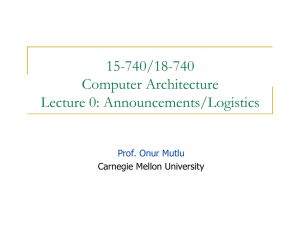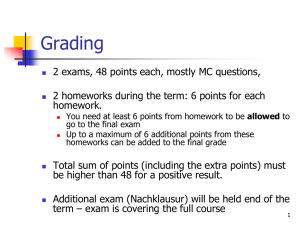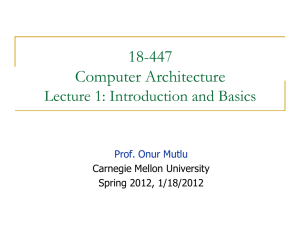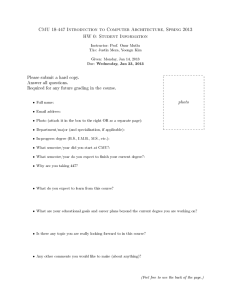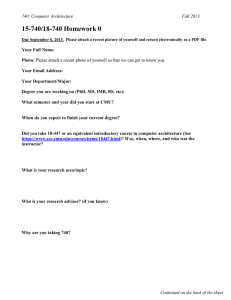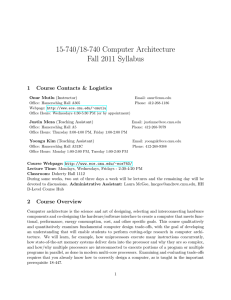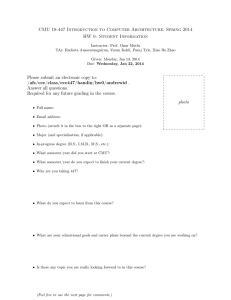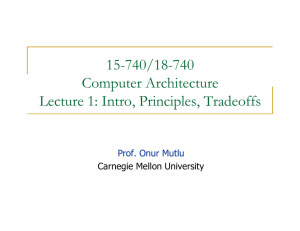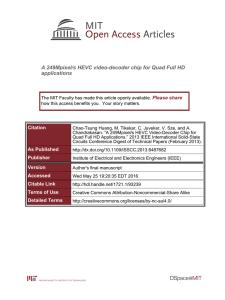15-740/18-740 Computer Architecture Lecture 0: Logistics and Introduction Prof. Onur Mutlu
advertisement
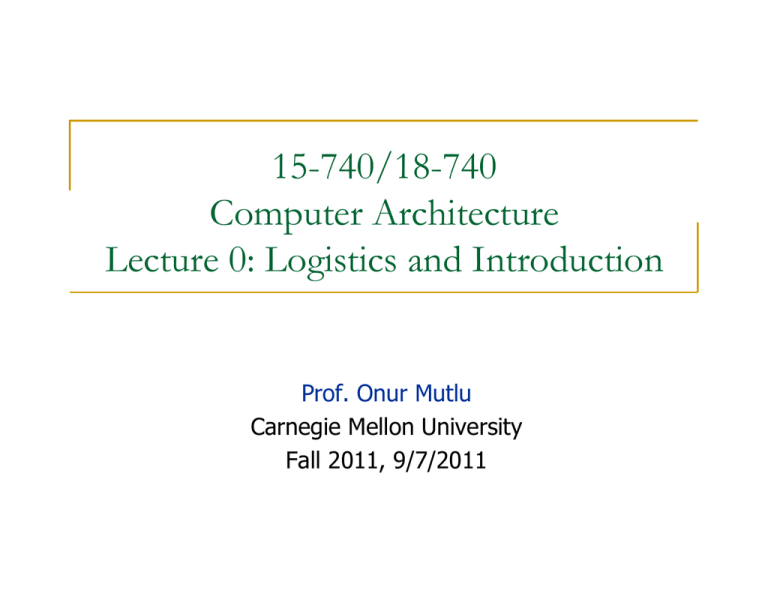
15-740/18-740 Computer Architecture Lecture 0: Logistics and Introduction Prof. Onur Mutlu Carnegie Mellon University Fall 2011, 9/7/2011 Summary First full-blown lecture: September 12 (Next Monday) Homework 0 Homework 1 Due September 14 (Next Wed) Review Set 1 (two seminal readings) Due September 16 (Next Fri) Review Set 0 (two readings) Due September 14 (Next Wed) Due September 16 (Next Fri) Project ideas and groups Proposal due September 26: Read, think, and brainstorm 2 Agenda Syllabus Course logistics, info, requirements Homework assignments for next week Reading/review assignments for next week Introduction Potential project topics 3 Course Info: Who Are We? Instructor: Prof. Onur Mutlu onur@cmu.edu Office: Hamerschlag Hall-A305 Office Hours: W 4:30-5:30pm (or by appointment) http://www.ece.cmu.edu/~omutlu PhD from UT-Austin, worked at Microsoft Research, Intel, AMD Research interests: Computer architecture, hardware/software interaction Many-core systems Memory and storage systems Improving programmer productivity Interconnection networks Hardware/software interaction and co-design (PL, OS, Architecture) Fault tolerance Hardware security Algorithms and architectures for genomics and embedded systems 4 Course Info: Who Are We? Teaching Assistants Yoongu Kim Hamerschlag Hall A313C yoongukim@ece.cmu.edu Office hours: Mon 1-2pm, Tue 1-2pm Justin Meza Hamerschlag Hall A5 justinme@ece.cmu.edu Office hours: Thu 3-4pm, Fri 1-2pm 5 Where to Get Up-to-date Course Info? Website: http://www.ece.cmu.edu/~ece740 Lecture notes Readings and link to review website Project information Homeworks Blackboard: Linked from website Upload homeworks here except for HW0 Your email Me and the TAs 6 Lectures and Course Schedule Reserved Lecture Times: MWF 2:30-4:20pm Doherty Hall 1112 Days and load will be determined dynamically. Some days, we might have discussion sessions. Tentative schedule in your syllabus But don’t believe all of it Systems that perform best are usually dynamically scheduled. Static vs. Dynamic Scheduling 7 What Will You Learn? Computer Architecture: The science and art of designing, selecting, and interconnecting hardware components and designing the hardware/software interface to create a computing system that meets functional, performance, energy consumption, cost, and other specific goals. Traditional definition: “The term architecture is used here to describe the attributes of a system as seen by the programmer, i.e., the conceptual structure and functional behavior as distinct from the organization of the dataflow and controls, the logic design, and the physical implementation.” Gene Amdahl, IBM Journal of R&D, April 1964 8 Levels of Transformation Problem Algorithm Programs User Runtime System (VM, OS, MM) ISA Microarchitecture Circuits/Technology Electrons 9 What Will You Learn? Hardware/software interface and major components of a modern microprocessor Hands-on research in a computer architecture topic State-of-the-art as well as research proposals Tradeoffs and how to make them Emphasis on cutting-edge research Semester-long project How to design better architectures (not an intro course) How to dig out information No textbook really required But, see the syllabus 10 An Example: Multi-Core Systems Multi-Core Chip DRAM MEMORY CONTROLLER L2 CACHE 3 L2 CACHE 2 CORE 2 CORE 3 DRAM BANKS CORE 1 DRAM INTERFACE L2 CACHE 1 L2 CACHE 0 SHARED L3 CACHE CORE 0 *Die photo credit: AMD Barcelona 11 Unexpected Slowdowns in Multi-Core High priority Memory Performance Hog Low priority (Core 0) (Core 1) 12 Why the Disparity in Slowdowns? CORE matlab1 gcc 2 CORE L2 CACHE L2 CACHE Multi-Core Chip unfairness INTERCONNECT DRAM MEMORY CONTROLLER Shared DRAM Memory System DRAM DRAM DRAM DRAM Bank 0 Bank 1 Bank 2 Bank 3 13 Course Goals Goal 1: To familiarize computer architecture students and those interested in computer system design with both fundamental design tradeoffs and recent research issues/trends in processor, memory, and platform architectures in today’s and future systems. Strong emphasis on fundamentals and design tradeoffs. Goal 2: To provide the necessary background and experience to advance the state-of-the-art in computer architecture by performing cutting-edge research. Strong emphasis on Critically evaluating research papers (through literature review assignments) Developing new mechanisms that advance the state of the art (through the course research project). 14 What Do I Expect From You? Required background: basic architecture (18-447), basic compilers, basic OS, programming Learn the material Do the work & work hard Ask questions, take notes, participate Read and review the assigned research papers & readings And, research it find the original source of ideas Discuss/critique them online with peers and us Write your critique/review online Come to class on time Start early and focus on the research project If you want feedback, come to office hours 15 How Will You Be Evaluated? Homeworks, Online Reviews, Quizzes: 10% Research Project: 35% Midterm I: 20% Midterm II (comprehensive): 35% Our evaluation of your performance: 5% Participation+discussion counts Grading will be back-end heavy. Most of your grade will be determined in December How you prepare and manage your time is important 16 More on Homeworks and Policy Homeworks Content from lectures, readings, project, discussions All homeworks must be your own work Do them to truly understand the material, not to get the grade Research project in groups Late policy: Maximum five late days total Absolutely no tolerance on cheating or academic dishonesty See syllabus, CMU Policy, and ECE Academic Integrity Policy Cheating Failing grade (no exceptions) 17 Research Project Your chance to explore in depth a computer architecture topic that interests you Perhaps even publish your innovation in a top computer architecture conference. Start thinking about your project topic from now! Interact with me and Yoongu, Justin Groups of 2-3 students (will finalize this later) Proposal due: Sep 26 18 Homeworks for Next Week Homework 0 Our way of getting to know about you fast Due Sep 14 You have to turn in a hard copy You have to turn in your picture Homework 1 Questions on initial readings and more Due Sep 16 Upload PDF on Blackboard 19 Readings+Reviews for Next Week Review Set 0 Due Sep 14 Ronen et al., "Coming Challenges in Microarchitecture and Architecture," Proceedings of the IEEE, vol. 89, no. 11, 2001. Patt, "Requirements, bottlenecks, and good fortune: agents for microprocessor evolution," Proceedings of the IEEE, vol. 89, no. 11, 2001. Review Set 1 Due Sep 16 G. M. Amdahl "Validity of the single processor approach to achieving large scale computing capabilities," AFIPS Conference, April 1967. G. E. Moore, "Cramming more components onto integrated circuits," Electronics, April 1965. 20 How to Do the Paper Reviews Brief summary is the problem the paper is trying to solve? are the key ideas of the paper? Key insights? is the key contribution to literature at the time it was written? are the most important things you take out from it? Strengths (most important ones) What What What What Does the paper solve the problem well? Weaknesses (most important ones) This is where you should think critically. Every paper/idea has a weakness. This does not mean the paper is necessarily bad. It means there is room for improvement and future research can accomplish this. Can you do (much) better? Present your thoughts/ideas. What have you learned/enjoyed most in the paper? Why? Review should be short and concise (~half a page or shorter) 21 Further Reading for Next Week Smith, “The Task of the Referee,” IEEE Computer 1990. Levin and Redell, “How (and how not) to write a good systems paper,” OSR 1983. Read this to get an idea of the publication process Read this for your research project Fong, “How to Write a CS Research Paper: A Bibliography” 22 Research Project Goal: Develop new insight Approach 1: Develop novel ideas to solve an important problem Rigorously evaluate the benefits and limitations of the ideas Approach 2: Derive insight from rigorous analysis and understanding of previously proposed ideas Propose potential new solutions based on the new insight The problem and ideas need to be concrete You should be doing problem-oriented research 23
